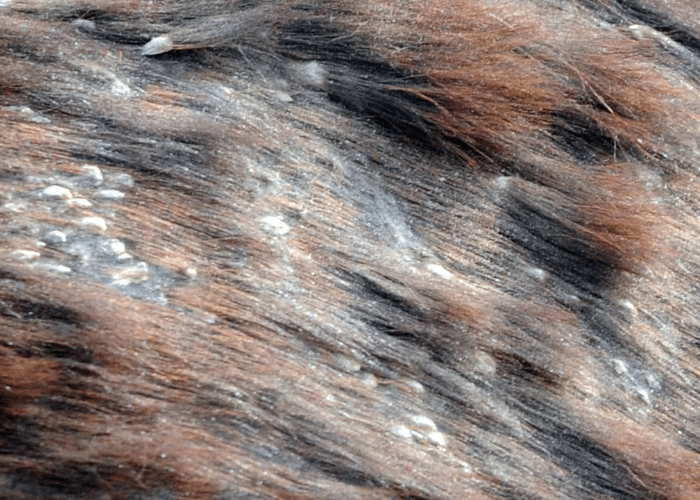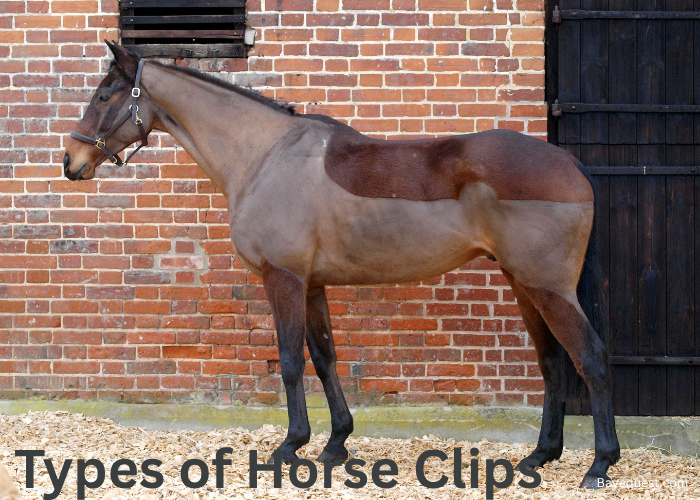Did you know that horse riding isn’t just one sport but a collection of diverse styles? With years of experience in equestrian sports, I’ve seen how choosing the right riding style can transform your riding experience.
Whether you’re curious about the elegance of dressage or the thrill of barrel racing, this article will guide you through the main types of horse riding styles.
Get ready to discover which one suits you best and how each offers unique challenges and rewards.
Horse Skin Conditions and Diseases: Key Takeaway
- Sarcoids
- Pastern Dermatitis
- Sweet Itch
- Rain Rot
- Eosinophilic Granulomas
- Melanoma
- Vitiligo
- Chronic Progressive Lymphedema (CPL)
- Ringworm
- Warts
- Cellulitis
- Sores (Habronemiasis)
- Squamous Cell Carcinoma
- Exuberant Granulation Tissue (Proud Flesh)
- Foliaceus
- Hereditary Equine Regional Dermal Asthenia (HERDA)
- Primary seborrhea (dandruff)
- Mange
- Lice (pediculosis)
The Importance of Skin Health in Horses
The skin is the largest organ of a horse’s body. It serves as a barrier protecting against environmental threats, infections, and diseases.
Its health is not just about keeping a horse looking good. It plays a vital role in the overall well-being and functionality of these majestic animals.
Here are some of the reasons why skin health in horses is so important:
First line of defense. The skin is the first barrier against bacteria, viruses, parasites, and harmful environmental substances. Healthy skin can effectively prevent these threats from entering the body and causing illness.
Temperature regulation. Horses regulate their body temperature through their skin. Sweat glands in the skin help to cool the horse down on hot days, while the hair and fat beneath the skin provide insulation during colder times.
Sensation and communication. The skin is packed with nerves that help a horse feel its environment, detect irritants, and even communicate with other horses and humans.
Indicator of overall health. Skin conditions can often be the first sign of more serious health issues. These may include nutritional deficiencies, internal diseases, or a compromised immune system. By paying attention to the skin, caretakers can catch and address these issues early.
Quality of life. Skin conditions can be uncomfortable, leading to itching, pain, or distress in horses. This discomfort can affect a horse’s behaviour, mood, and performance.
Read also: Why horses roll.
19 Equine Skin Diseases and Conditions
Discover the 19 most common skin problems in horses, and learn how to identify and manage these equine skin diseases and conditions.
1. Sarcoids
Sarcoids in horses can be a bit of a puzzle. These skin tumors aren’t your everyday bump or lump. They have their own set of rules.
Let’s break down what they are, how they show up, how to dodge them, and what to do if your horse gets one.
Causes and causative agent
The story behind sarcoids is linked to Bovine Papillomavirus (BPV). This virus is the main culprit, but it doesn’t act alone.
For a horse to develop a sarcoid, there usually must be a mix of the virus and skin damage or irritation. It’s like the virus finds a tiny doorway through a scratch or wound and decides to move in.
Signs and symptoms/Appearance
Sarcoids can be quite the chameleons. They come in different looks. Some are flat and blend into the skin, while others are bumpy or warty.
You might even see some that look like open sores. They can pop up anywhere on the body, but they like places where the skin is thin or where there’s a lot of friction.
Prevention
When it comes to dodging sarcoids, keeping things clean is key. Since skin damage can invite the virus in, maintaining good grooming habits and taking care of any cuts or scratches right away can help.
Fly control is also a big deal because flies can spread the virus from one spot to another or even from horse to horse.
Treatment
Treating sarcoids can be tricky. There’s no one-size-fits-all solution. Sometimes, leaving them alone is the best choice if they’re not causing trouble.
When action is needed, options range from creams and ointments to freeze them off (cryotherapy), zapping them with lasers, or sometimes surgery.
The goal is to kick the sarcoid out without inviting more to the party by causing more skin damage.
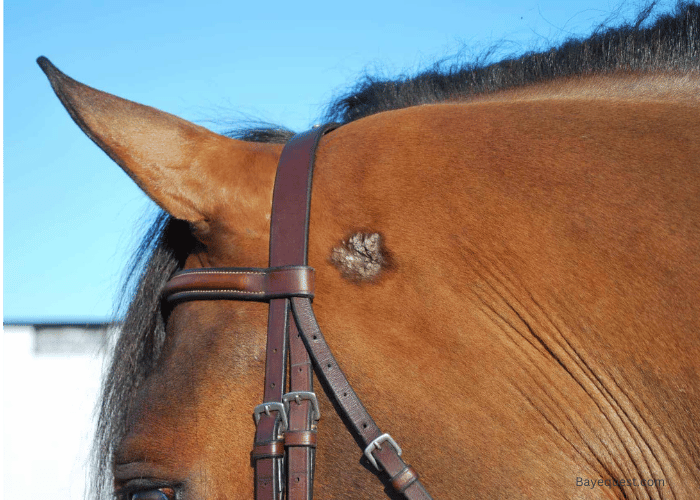
2. Pastern Dermatitis
Pastern dermatitis, often known as “mud fever” or “scratches,” can be a real thorn in a horse’s side or feet. Let’s break this down into bite-sized pieces, focusing on the causes, what it looks like, how to prevent it, and how to treat it.
Causes and causative agent
At the heart of pastern dermatitis is irritation and inflammation of the skin around the pasterns. Wet, muddy conditions are usual suspects, as they soften the skin and make it more vulnerable.
Bacteria, mites, and sometimes fungal infections see this as a VIP pass to cause trouble. Essentially, anything that irritates or breaks the skin in this area can roll out the red carpet for pastern dermatitis.
Signs and Symptoms/Appearance
When pastern dermatitis shows up at the party, it’s hard to miss. You’ll see redness, swelling, and scabs that can crack and bleed in severe cases.
It can make a horse’s legs look like they’re wearing crusty, uncomfortable socks. The area can be sore, and your horse might not appreciate you touching it.
The hair can sometimes fall out, leaving bare, sensitive spots.
Prevention
Keeping the pastern area dry and clean is your best defense against pastern dermatitis. After rides or turnout in wet conditions, rinse and dry your horse’s legs.
Regular grooming helps too, as it keeps the skin healthy and can catch problems early. Consider barrier creams or protective boots during muddy seasons for horses that seem to get this easily.
Treatment
Treating pastern dermatitis involves a few key steps: clean, treat, and protect. Start by gently cleaning the area with a mild antiseptic solution to remove mud and scabs. This might require some soaking to soften things up.
Then, apply treatment creams or ointments recommended by your vet. These could be antibacterial, antifungal, or steroid-based, depending on the cause.
Finally, keep the area dry and protected, possibly bandaging it to prevent further irritation or infection.
3. Sweet Itch
Sweet itch, also known as summer itch or Queensland itch, is the bane of many horses and their owners during the warmer months. Let’s get into deets:
Causes and Causative Agent
The main villain behind sweet itch is the Culicoides biting midge. These tiny insects are not just annoying. They’re also the carriers of the allergen that causes the allergic reaction in horses.
When they bite, they inject saliva into the skin. This is like lighting a match to Tinder. The immune system of the horses reacts strongly, leading to itching and inflammation.
Signs and Symptoms/Appearance
Sweet itch is like an uninvited itch that just won’t quit. Affected horses will scratch, bite, and rub against anything they can find, trying to get relief.
This usually leads to hair loss, broken skin, and sometimes even sores, mainly around the mane, tail, and sometimes the back or belly. It’s heart-wrenching to watch and frustrating for the horse.
Prevention
Preventing sweet itch centers on keeping those pesky midges at bay. This means managing your horse’s environment.
Use fine mesh insect screens and fans to disrupt midges’ flight, and avoid turnout during dawn and dusk when midges are most active.
Protective blankets and fly repellents designed to fend off midges can also help.
Treatment
Once sweet itch has taken hold, the focus shifts to soothing the skin and breaking the itch-scratch cycle. Corticosteroids can reduce inflammation and itching, but they’re usually a short-term fix due to potential side effects.
Topical treatments like medicated shampoos and creams can soothe and protect the skin. Supplements designed to support skin health may also help from the inside out.
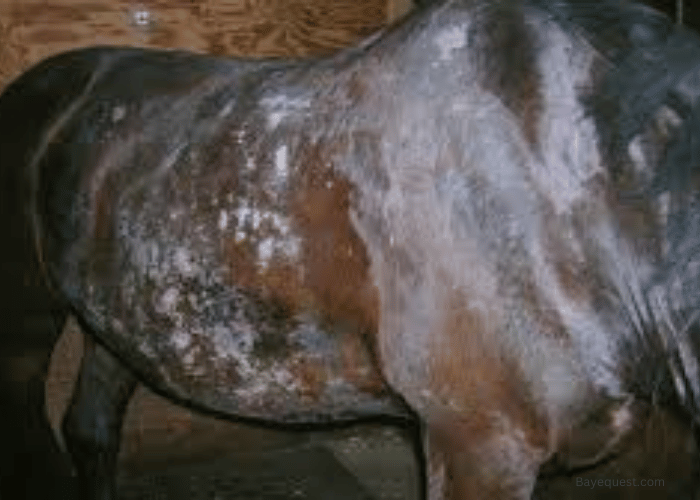
4. Rain Rot
Rain rot, also known as rain scald, is like the unwelcome guest of the equine world that shows up after too much-wet weather. Let’s get into what causes it, its signs, how we can try to prevent it, and what to do if your horse gets it.
Causes and Causative Agent
Rain rot is caused by bacteria called Dermatophilus congolensis. This bacteria is quite the opportunist. It lies dormant on the horse’s skin until prolonged wetness, humidity, or insect bites provide the perfect conditions for it to awaken and invade.
The bacteria get busy once the skin is compromised, causing lesions and scabs.
Signs and Symptoms/Appearance
The hallmark of rain rot is a series of crusty, scabby lesions that can feel like lumps under the horse’s coat. This is often along the back, rump, and sometimes on the legs.
When you pull these scabs away, they might take hair with them, leaving bald spots that can be quite tender. It’s not a pretty sight and can be uncomfortable for the horse.
Prevention
Preventing rain rot is all about keeping the skin dry and healthy. After your horse gets wet, whether from rain or sweat, drying them off can help.
Regular grooming not only keeps the skin and coat healthy but also helps to spot any issues early. Keeping track and blankets clean and dry is also crucial, as these can harbour bacteria.
Treatment
Treating rain rot involves a bit of elbow grease. The goal is to remove the scabs gently and treat the skin underneath.
This might mean bathing your horse with an antimicrobial shampoo and carefully removing loose scabs. Be gentle to avoid causing more skin trauma.
Afterwards, apply a topical antiseptic to help heal the skin.
5. Eosinophilic Granulomas
Eosinophilic granulomas in horses are like those mysterious bumps that suddenly appear, leaving you guessing how they got there. Let’s look deeper into it:
Causes and Causative Agent
These granulomas are a type of allergic reaction. They can be the body’s response to various irritants or allergens.
The exact cause can be tricky to pinpoint because it’s often a reaction to a mix of factors rather than one single culprit. The body sends eosinophils to the site of the irritation, which results in the formation of granulomas.
Signs and Symptoms/Appearance
Eosinophilic granulomas show up as nodules or bumps on the skin. These bumps can vary in size. They are typically found on the horse’s back, sides, or neck but can pop up almost anywhere.
The nodules may be firm and sometimes cause the horse discomfort if located in areas that interfere with tack or equipment.
Prevention
Keeping your horse’s environment clean, minimizing insect exposure, and maintaining a healthy diet can help. Regular check-ups with your vet can also catch any underlying health issues that might contribute to the problem.
Treatment
Treating eosinophilic granulomas often requires a two-pronged approach. Addressing the granulomas and managing any underlying conditions or allergens causing the reaction.
Your vet might recommend corticosteroids to reduce inflammation and the immune response. In some cases, the nodules can be removed surgically or treated with cryotherapy (freezing).
6. Melanoma
Many horse owners are concerned about melanoma in horses, especially gray ones. Let’s unpack this condition, keeping things clear and straightforward.
Causes and Causative Agent
Melanomas are tumors that arise from pigment-producing cells known as melanocytes. In horses, these are often linked to genetics, with gray horses being particularly prone as they age.
The exact trigger for these cells turning into melanomas isn’t fully understood. However, it’s believed that a combination of genetic predisposition and possibly sun exposure plays a role.
Signs and Symptoms/Appearance
Melanomas usually appear as firm, black lumps under the skin. They’re most commonly found around the tail, under the mane, and in the genital area.
Initially, they might not cause any discomfort or issues for the horse. However, they can interfere with the horse’s comfort and function as they grow.
Prevention
There’s no surefire way to prevent them, especially in gray horses. Limiting excessive sun exposure might help reduce the risk, although the effectiveness of this is more speculative than proven.
Treatment
Treatment options for melanomas can vary. In many cases, if the tumors aren’t causing immediate issues, they might be left alone with a watch-and-wait approach.
If they grow or start to affect the horse’s quality of life, treatments may include surgical removal, cryotherapy (freezing), or immunotherapy.
7. Vitiligo
Vitiligo in horses, sometimes known as pinky skin or leopard complex, changes appearance but is usually more of a cosmetic concern. Let’s navigate through the whats and hows of vitiligo in horses.
Causes and Causative Agent
The exact cause of vitiligo is a bit of a mystery. It’s thought to be an autoimmune condition where the horse’s body mistakenly attacks its pigment cells, leading to loss of color.
Genetics may play a role. Certain breeds seem more prone to it, suggesting a hereditary component. Stress and environmental factors might also contribute, but pinpointing a single cause is challenging.
Signs and Symptoms
Vitiligo is most noticeable for the depigmentation it causes. It leads to white or pink skin patches, especially around the eyes, mouth, and under the tail.
Initially, you might see small areas of lighter skin that gradually expand. Unlike other conditions, it doesn’t cause discomfort or itching; it’s all about the look.
Prevention
Since the root cause of vitiligo remains elusive and might be largely genetic, there’s no known prevention strategy. However, maintaining overall good health and minimizing stress might be beneficial.
Treatment
There’s no cure for vitiligo, and treatment is usually unnecessary since it doesn’t affect the horse’s health or quality of life beyond the cosmetic aspect.
8. Chronic Progressive Lymphedema (CPL)
CPL is a condition that can cause a fair bit of discomfort for horses. It particularly affects breeds like Shires, Clydesdales, and Belgians.
Let’s break it down into bite-sized pieces for better understanding.
Causes and Causative Agent
CPL is a progressive condition involving the lymphatic system, which is responsible for draining excess fluids from tissues. In horses with CPL, this system doesn’t work as it should, leading to chronic swelling, inflammation, and tissue changes.
Appearance
CPL shows persistent swelling in the lower legs, especially around the fetlocks and pasterns. Over time, the skin in these areas becomes thicker and harder and may develop folds prone to infection and ulceration.
You might also see weeping sores and hair loss in affected areas. This condition gradually worsens, causing discomfort and mobility issues for the horse.
Prevention
Preventing CPL starts with breeding responsibly and avoiding the mating of horses known to carry the predisposition for this condition. Diligent leg care is paramount for horses at risk or beginning to show signs.
Treatment
There’s no cure for CPL, but management focuses on reducing discomfort and preventing secondary infections.
This involves regular veterinary care, including careful leg cleaning, use of medicated shampoos, and application of protective barriers or bandages as needed.
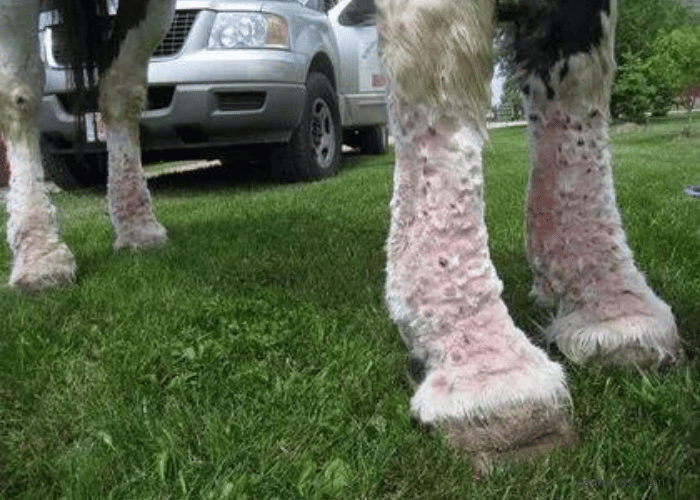
9. Ringworm
Ringworm in horses isn’t a worm at all but a fungal infection affecting skin, hair, and sometimes even nails. Let’s trot through the essentials of ringworm:
Causes
The troublemakers behind ringworms are fungi, with names like Trichophyton and Microsporum. These fungi love warm and moist places and can spread from horse to horse.
Signs and Symptoms
Ringworm makes itself known through circular, bald patches on the horse’s skin. These patches can look scaly or crusty, and while they might not itch like crazy, they’re not exactly a beauty mark.
You’ll usually spot them on the head, neck, or legs, but they can appear anywhere.
Prevention
Keeping ringworms at bay requires cleanliness and caution. The key is to regularly clean and disinfect tack, grooming tools, and stables.
Isolating new horses until they’re fungus-free can also prevent an outbreak. And since fungi can linger, treating the environment is just as crucial as treating the horse.
Treatment
When ringworm appears, treatment involves topical antifungal creams or shampoos to kill the fungus. In more stubborn cases, a vet might prescribe oral antifungal medications.
10. Warts
Warts in horses, often popping up around the muzzle and eyes, are usually more of a cosmetic concern than a serious health issue. A virus causes them to look odd, but they can be tackled with care. Let’s dive into the details.
Causative Agent
The equine papillomavirus is the ringleader behind warts in horses. It targets the young and the restless—mostly affecting horses under 3 years old.
The virus takes advantage of their still-developing immune systems to set up shop.
Appearance
Warts have a distinctive look. They are small, rough, and often clustered together like tiny cauliflower.
While they favor the muzzle and areas around the eyes, they can also appear on the genitals or under the belly.
Aside from possibly being a bit unsightly, these growths are generally harmless and don’t bother the horse.
Prevention
Since warts are viral, preventing them involves minimizing direct contact with infected horses.
Maintaining good hygiene practices in your stable can help reduce the spread of the virus among young horses.
Treatment
Most of the time, warts will fade away as mysteriously as they appeared. This is because the horse’s immune system clears the virus, usually within a few months. If warts are problematic or don’t go away independently, a vet might step in with treatments.
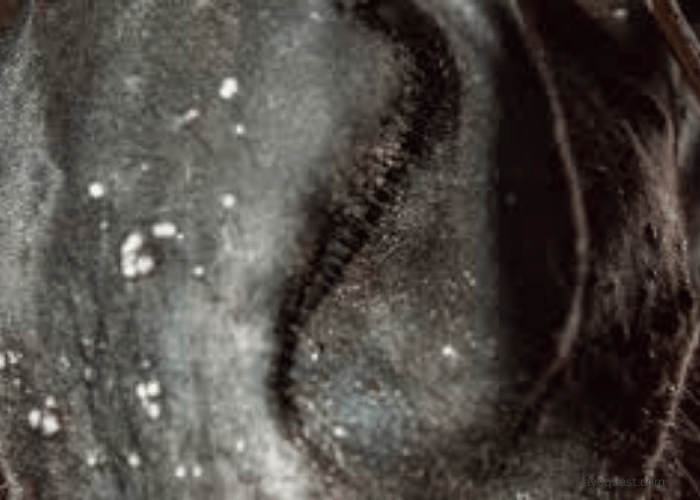
11. Cellulitis
Cellulitis in horses is a condition that can get under the skin—literally. It’s an infection of the deep layers of the skin and the tissues underneath, causing swelling, pain, and sometimes much trouble.
Let’s break down the causes, signs, prevention, and treatment in a way that’s easy to understand.
Causative Agent
Bacteria are the main culprits behind cellulitis. They often enter through a tiny cut or abrasion that might not even be noticeable.
Once these bacteria sneak in, they set up shop, leading to infection and inflammation. The usual suspects include Streptococcus and Staphylococcus species.
Appearance
Cellulitis manifests as swelling, usually in one of the horse’s legs. The affected area can feel hot and tender, and the horse might show signs of pain when touched.
Fever, lethargy, and a decreased appetite can also be telltale signs that something’s amiss.
Prevention
Preventing cellulitis involves monitoring your horse’s skin and treating any cuts or scrapes promptly and properly.
Good stable hygiene and regular grooming can help catch potential entry points for bacteria before they become a problem. Fly control is also important.
Treatment
Treatment usually involves antibiotics to fight the infection. Cold hosing and sometimes anti-inflammatory medications might also be used to reduce the swelling and discomfort.
12. Summer Sores (Habronemiasis)
Summer sores, or habronemiasis, can turn warm, sunny days into a nuisance for horses. Caused by a parasitic worm but manifesting on the skin, these sores can be a real headache.
Here’s a straightforward look at causes, signs, prevention, and treatment.
Causes
The story begins with the stomach worms Habronema and Draschia. The larvae of these parasites are expelled in the horse’s faeces, where they are picked up by house or stable flies.
When flies land on a horse’s wound, moist skin area, or even the eyes or mouth, they deposit these larvae. Instead of completing their normal lifecycle in the horse’s stomach, these larvae cause inflammation and irritation on the skin, leading to summer sores.
Signs
Summer sores are hard to miss. They appear as raw, weeping, and sometimes crater-like lesions that don’t heal.
These sores can be quite itchy and irritating for the horse, leading to rubbing and further damage. You’ll find them where flies like to land: on the legs, around the eyes, mouth, and even the genital areas.
Prevention
Preventing summer sores is largely about controlling flies and managing wounds. Keeping your horse and their environment clean can reduce fly populations.
Regular deworming plays a crucial role, too.
Treatment
First, it is key to get rid of the larvae with appropriate medication, usually prescribed by a vet. This might involve oral dewormers or topical treatments directly on the sores.
Managing the sore through cleaning, keeping it covered, and sometimes surgical removal of the coarse tissue can help it heal.
13. Squamous Cell Carcinoma
SCC in horses is a common type of skin cancer that demands attention for its potential seriousness.
Causes
SCC is linked to sun exposure, particularly affecting areas of the skin that are lightly pigmented and less hairy. UV light damage is thought to play a role, though viruses like papillomavirus have been implicated in some cases.
Signs and Symptoms
Initially, SCC may look like a small, scaly patch, wart, or lump that doesn’t seem to heal. These lesions can become ulcerated, leading to more pronounced growths.
Common sites for SCC include the eyelids, genitals, and muzzle, frequently exposed to sunlight.
Prevention
Protecting horses from excessive sun exposure is key. This can include providing shaded areas during peak sunlight hours.
Using UV-protective fly masks for the face, and applying sunblock to vulnerable areas is also a preventive measure.
Treatment
The approach to treating SCC depends on the tumor’s size, location, and whether it has spread. Surgical removal is often the first line of defence. In some cases, topical chemotherapy can be effective, especially for smaller lesions.
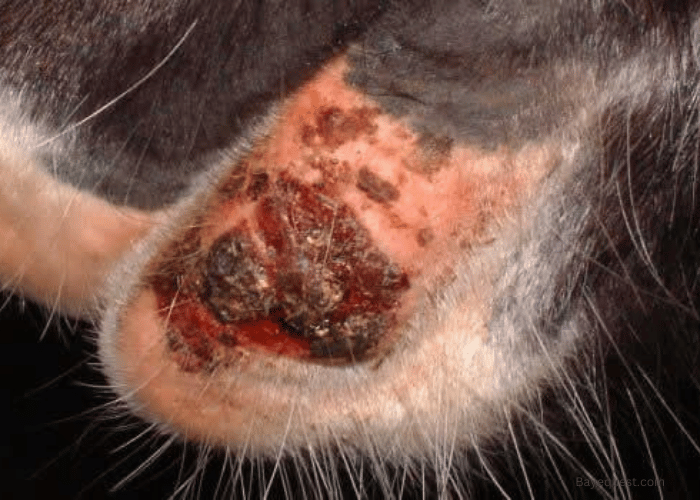
14. Exuberant Granulation Tissue (Proud Flesh)
Exuberant Granulation Tissue, commonly known as Proud Flesh, is a condition that can complicate wound healing in horses.
Causes
Proud Flesh develops when the body’s natural healing process goes into overdrive at the site of a wound. Instead of forming a scar to heal over a wound, the horse’s body produces too much granulation tissue.
This excessive tissue growth can be attributed to the high mobility and poor blood supply in these areas.
Signs and symptoms
The hallmark of Proud Flesh is an overgrowth of pink, fleshy tissue emerging from a wound site. It can appear bulbous and will bleed easily if bumped or touched.
This excessive tissue growth can stall the healing process, leading to a wound that remains open and unhealed.
Prevention
Preventing Proud Flesh involves proper wound care from the outset. Initial cleaning and dressing of wounds to protect them from infection and disturbance are critical.
Also, minimize movement of the affected area and ensure a clean healing environment.
Treatment
The treatment requires reducing the excessive tissue to allow the wound to heal properly. This might involve surgical removal of the overgrown tissue.
In some cases, corticosteroids are used to reduce inflammation and slow the formation of Proud Flesh.
15. Pemphigus Foliaceus
Pemphigus Foliaceus is a rare but serious autoimmune skin disorder that affects horses, among other animals. This condition occurs when the horse’s immune system mistakenly attacks the connections between skin cells.
This leads to the formation of pustules and erosions on the skin.
Causes
The exact trigger of Pemphigus Foliaceus is not well understood, but it is known to be an autoimmune disorder. In affected horses, the immune system produces antibodies against desmoglein I, a protein that helps skin cells stick together.
Signs
The disease manifests as clusters of small, fluid-filled blisters that burst, leaving crusty, scaly patches behind. These lesions are often found on the head, ears, and limbs but can spread to other body parts.
Affected horses may appear uncomfortable or itchy.
Prevention
Unfortunately, there is no known prevention since its cause is not fully understood and is related to the horse’s immune system.
Treatment
Treatment focuses on suppressing the immune system to halt the attack on the skin cells.
16. Hereditary Equine Regional Dermal Asthenia (HERDA)
HERDA, or Hyperelastosis Cutis, is a genetic skin condition affecting Quarter Horses and related breeds. It’s a disorder that horse owners and breeders watch out for because of its impact on the animal’s health and quality of life.
Causes
HERDA is a hereditary condition caused by a genetic mutation that affects the production of collagen. Horses with HERDA have one copy of the gene from one parent, as having two copies (homozygous) is lethal in utero.
Signs and symptoms
Horses with HERDA often show signs around 2 to 3 years of age, when their skin becomes unusually stretchy and fragile. Affected areas can tear or scar easily from normal contact or pressure.
This leads to large, open wounds that heal poorly. The skin might also appear loose or wrinkled; in severe cases, the affected areas can hinder the horse’s movement or saddle fitting.
Prevention
Since HERDA is a genetic disorder, prevention focuses on responsible breeding practices. Testing breeding horses for the HERDA gene is crucial to avoid producing affected offspring.
Treatment
HERDA has no cure; treatment revolves around managing symptoms and preventing skin damage.
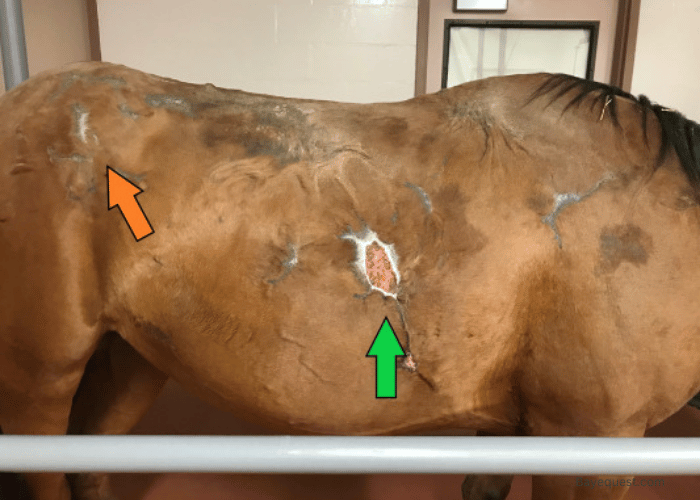
17. Primary seborrhea (dandruff)
Primary seborrhea, or dandruff, is a skin disorder that can affect horses. This condition manifests through producing dry, flaky or oily, greasy skin.
Causative agent
Primary seborrhea is considered a genetic condition in horses, meaning it’s inherited from the parents. It results from abnormal functioning of the sebaceous glands, which produce sebum.
Signs and Symptoms
The most noticeable sign of primary seborrhea in horses is flaky skin, similar to dandruff in humans. Depending on whether the seborrhea is oily or dry, this can be accompanied by either an excessively oily coat or a dry, brittle coat.
Prevention
Because primary seborrhea is genetic, there’s no sure way to prevent the condition itself.
Treatment
Treatment for primary seborrhea aims to manage symptoms and improve the horse’s skin condition. Regular bathing with medicated shampoos to treat seborrheic skin can help control flaking and oiliness.
18. Mange
Mange in horses is a skin condition caused by various types of tiny mites that burrow into the skin or hair follicles. Let’s explore the causes, signs, prevention, and treatment strategies for mange.
Causes
There are a few different types of mites responsible for mange. Sarcoptes, Chorioptes, and Psoroptes are the most common culprits.
These mites are highly contagious and can spread between horses through direct contact or contaminated fomites.
Appearance
The general signs of mange include intense itching, leading to relentless scratching, biting, or rubbing against objects. This behavior can result in hair loss, thickened skin, and sores or scabs.
The appearance of the affected skin varies with the type of mite. Chorioptes affect the legs, causing crusty, flaky skin, while Sarcoptes can lead to scaly lesions and hair loss on the head, neck, and belly.
Prevention
Preventing mange involves maintaining good hygiene practices in the stable and among the horses. This includes regularly cleaning and disinfecting grooming tools, tack, and stables. Isolating new or infected horses to prevent the spread of mites.
Treatment
Treatment of mange in horses requires eradicating the mites, soothing the skin, and preventing secondary infections.
19. Lice (pediculosis)
Lice infestation, or pediculosis, is a pesky problem in horses that can cause discomfort and irritation. These tiny parasites live on the skin and feed on blood or skin debris, depending on their type.
Let’s delve into the causes, signs, prevention, and treatment of lice in horses.
Causes
Two main types of lice affect horses: chewing lice (Bovicola equi) and sucking lice (Haematopinus asini). Chewing lice feed on skin debris while sucking lice feed on blood.
Lice are spread through direct contact between horses or contact with contaminated equipment.
Appearance
Horses infested with lice may show restlessness and discomfort due to itching. You might notice them rubbing against posts, walls, or other objects to relieve the itch.
Visual inspection can reveal lice or their eggs (nits) attached to the hair, especially around the mane, tail, and other body parts with long hair.
Prevention
Preventing lice infestation involves good hygiene practices and regular grooming. Clean and disinfect grooming tools and equipment regularly, and isolate any new horses until they have been checked for lice.
Keeping horses healthy and stress-free can also make them less susceptible to infestation.
Treatment
Treatment for horse lice includes using insecticidal sprays, shampoos, or powders. It’s important to treat all horses in contact with the infested animal.
Cleaning and disinfecting stalls, bedding, and all equipment the horse has come into contact with helps to prevent re-infestation.
Read also: How to build a horse’s topline.
Horse Skin Problems: Conclusion
And there we have it, folks—a gallop through the pesky skin conditions that can affect our noble steeds. We’ve untangled the mysteries of equine skin health from the sun-drenched nuisances of Squamous Cell Carcinoma to the itchy lice invasions.
Remember, while some of these conditions sound like horsemen’s lore, armed with knowledge, vigilance, and a good vet on speed dial, you’re well-equipped to keep your horse’s coat shining, skin healthy, and tails high.
Also, check out our article on Equine strangles to find more about this disease, its causes, signs and symptoms and how it can be treated.




